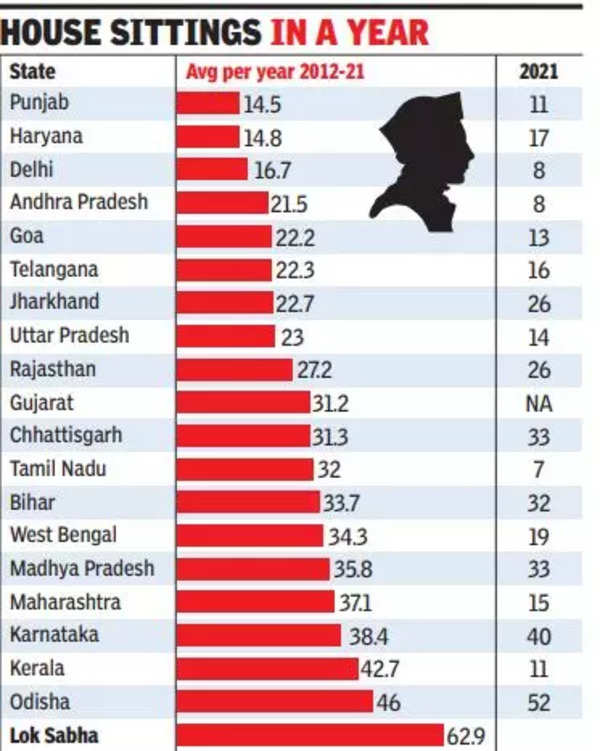
- Home
- About
- Knowledge Center
- Legislative Landscape
- Resources
- #TOGETHERFORBHARA
The State Legislature, an essential component of the democratic framework in the States of India, serves as the primary Legislative body responsible for enacting laws, shaping policies, and representing the interests and aspirations of the citizens at the State level. However, in the last few years, we have observed a trend that suggests these institutions are not performing their primary objectives of debating and legislating for the State in line with the expectations of the constitution makers.
A recent report by PRS Legislative Research highlights this issue. According to the report, State Legislature in India convened for an average of 21 days in 2022, with a consistent decline in sittings since 2016. Surprisingly, among States, Karnataka met for the highest number of 45 days, followed by West Bengal (42 days) and Kerala (41 days). Even these limited meetings are mostly clubbed in a single Budget session. It resulted in longer Budget Sessions incorporating 61% of sittings followed by shorter Monsoon and Winter Sessions. Additionally, the average duration of a sitting also remained low, with 20 States having an average of 5 hours, but it varied significantly state by state.

The report also mentions that the National Commission to Review the Working of the Constitution (NCRWC, 2002), recommended States to set a minimum number of sitting days for their Legislatures based on the number of members. Still, none have consistently met these targets since 2016. Additionally, it was observed that many bills were passed quickly with minimal debate, with 59% of bills introduced in 2022 being passed on the day of introduction or the next day. Only a few bills were referred to committees for in-depth examination across States. Furthermore, Article 174 of the Indian Constitution stipulates that State Legislatures must convene within a six-month interval but does not specify a minimum number of sitting days. In 2002, the NCRWC, to enhance Legislative efficiency proposed that State Legislatures with fewer than 70 members meet for at least 50 days annually, while larger houses should convene for at least 90 days. Still, State Legislatures are yet to work on this proposal.
Debates and Discussions have been the major aspect of the Bhartiya tradition. But in years since independence, despite the emphasis made by our Constitution makers, the decline of debates in The Legislature has been persistent. However, this impacts the State Legislature more than the Parliament as, unlike Parliament, the State Legislatures do not have active standing committees. Furthermore, its role is not limited to law-making as, through various mechanisms, it acts as an overseeing body on the work of the Executive (Government). Fewer sittings of the Assembly adversely impact its responsibility of scrutiny. Due to a lack of adequate sittings, the members do not have sufficient time to prepare for the deliberation on bills, and several of them are passed without much discussion. The Assembly is also responsible for scrutinizing budgetary proposals before approving them. Its failure to meet more often results in the budgets of many departments being passed without detailed discussion.

Now, if we look at the factors responsible for this decline, firstly, the lack of independence of the Legislature to determine its sittings is a significant concern. In countries like India, the governor of a State convenes the Assembly based on the recommendation of the Cabinet, effectively placing control over the Legislature’s sittings in the hands of the State government. This undermines the essential role of the Legislative Assembly in holding the Government accountable for its actions and decisions. Secondly, there is a growing awareness gap among Assembly members regarding the importance of active and substantive discussions. This lack of understanding can reduce enthusiasm for attending sessions and engaging in meaningful debates. Thirdly, inadequate media coverage of Legislative proceedings contributes to the problem. Political leaders may perceive little benefit in dedicating their time to these discussions, as they often do not translate into electoral gains, diminishing their incentive to participate actively. Lastly, frequent disruptions to the functioning of Legislatures, such as protests and walkouts, further hamper the regularity of sittings and hinder productive Legislative work. Addressing these issues is crucial to ensure the vitality and effectiveness of The Legislatures in democratic governance.
Hence, Government and civil societies must collaboratively endeavour to rekindle the culture of deliberation within Legislature, as this resurgence holds the potential to yield substantial benefits. Not only will it enhance the decision-making processes within the Government, but it will also empower citizens to monitor the functioning of their representatives closely. Moreover, opposition parties stand to gain significantly from such a revival, as it enables them to scrutinize the activities of the Executive branch in the context of public interest. To further incentivize the active participation of leaders, it is imperative to boost media coverage of these deliberations and establish a fixed calendar for Legislative sittings, as practiced in many countries worldwide. While certain initiatives have already begun in this direction, such as the National Legislators’ Conference Bharat (NLC Bharat) organized by MIT School of Government, Pune which enables and facilitates interactions among MLAs across the nation, much work still remains to be done.
Finally, the State Legislatures are the enabling unit of Democratic values in India. However, in recent pasts, these units have ceased to function properly, but with proper intervention at various levels, which include the Central Government making laws and educating the legislators about their roles and responsibilities, the working of Legislatures can be ensured.
